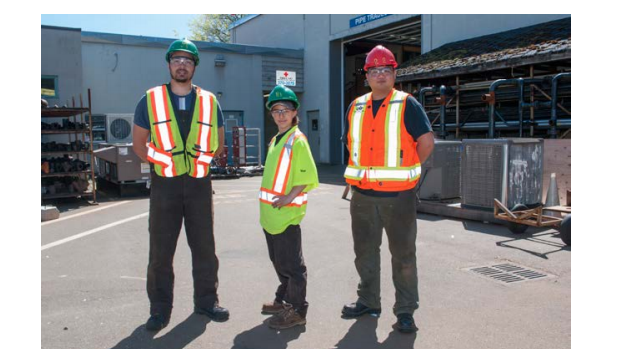LEARNING TASK 1 : Describe safety gear and work clothing
Personal apparel
Workers are required to supply the appropriate safety footwear and suitable clothing before being permitted to work in a shop or on a work site. There are a number of important safety considerations to be aware of for clothing, hair, and jewellery that are common to all job sites.
Clothing
Workers must wear close-fitting clothing (that is, not ragged or frayed) if they are working near moving machinery. Scarves, ties, shirts, pant cuffs, and gloves may become workplace hazards. For example, if your shirt cuff is loose, you risk getting it caught in a machine and injuring or breaking your arm if it is pulled around the shaft.
Oily, greasy, and/or synthetic clothes (e.g., rayon, nylon, polyester) are of concern when working near sparks or open flames. As well as being fire hazards, oily or greasy clothes may cause skin irritation.
Workers must use clothing to protect the body from as much dirt and as many chips and sparks as possible. Short pants, short-sleeved shirts, and sandals are not considered adequate on most job sites.
Pant legs should not be tucked inside boots when working with or near a torch, grinder, or chipper. Hot pieces of metal may fall inside a boot and cause a bad burn before the boot can be removed. Workers may also require flame-resistant clothing if they are working where they may be exposed to flash fires or similar hot work hazards.
High-visibility apparel
Wear high visibility clothing in a colour that contrasts with the environment so you can be seen at a distance. Make sure your high-visibility clothing is not covered by other garments. You must wear it when:
- working around any moving vehicles, equipment, or lines
- working alone or in isolation
- harvesting trees at night
- performing traffic control in work areas where there is vehicle traffic moving through a work zone or for falling operations
- directing helicopter movements

Loose-fitting high-visibility outer clothing must be “tear-away” if worn for work where it could get caught on moving equipment or on objects such as branches or limbs.
Hair and beards
Workers with long hair should wear a cap or a hairnet. In addition, beards should be trimmed. Both hair and beards can get caught in machinery or catch fire from sparks or an open flame. Beards may also prevent respirators from fitting properly, which could result in the inhalation of hazardous materials.
Jewellery
Workers must not wear rings, metal watchbands, bracelets, neck chains, or necklaces on a job site. Wearing these items can cause:
- a bad burn, if a metal object (for example, a watchband) touches a hot battery terminal and some other grounding object
- a shock, if working on electrical equipment that has electrical power applied
- loss of a finger, if a ring gets caught in a piece of machinery
Special clothing and gear for various weather conditions
Since many trades have to work in poor weather, workers must have adequate rain gear and warm clothing. Keeping dry is very important for staying warm. When you’re wet, you lose body heat faster.
Some raincoats are designed with vents, which help draw off perspiration. The raincoat should be large enough to allow arms to move freely. The collar should have a cloth cover to protect the neck from the coat’s cold, wet material.
Rain pants keep the lower body dry. If you wear only a raincoat, water dripping off the coat will make your legs wet and uncomfortable. It’s also important to keep your feet dry so they stay warm. Rubber boots with steel toe protectors and steel sole plates are available.
To work safely in cold weather, it is important to wear properly insulated headgear, footwear, and gloves. Wear layered clothing, as layers allow warm air to stay trapped but do not trap perspiration next to the skin. The first layer of clothing should be a wicking fabric like polypropylene or knitted silk, which will allow the skin to breathe by allowing sweat to escape. The second layer of insulating clothing should be a fabric that absorbs perspiration but does not allow heat to escape. Wool is ideal because it keeps you warm even when wet. The final layer must be able to keep out water and wind.

